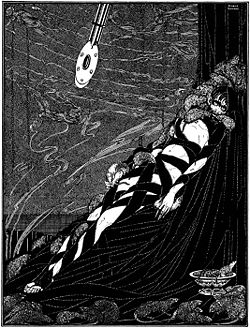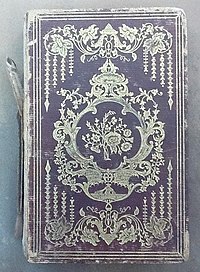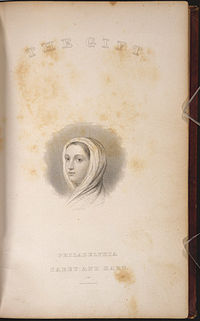The Pit and the Pendulum
| "The Pit and the Pendulum" | |
|---|---|
| Short story by Edgar Allan Poe | |
 | |
| Country | United States |
| Language | English |
| Genre(s) | Horror Short story |
| Publication | |
| Published in | The Gift: A Christmas and New Year's Present for 1843 |
| Publication type | Periodical |
| Publisher | Carey & Hart |
| Media type | |
| Publication date | 1842 |
"The Pit and the Pendulum" is a short story by American writer Edgar Allan Poe and first published in 1842 in the literary annual The Gift: A Christmas and New Year's Present for 1843. The story is about the torments endured by a prisoner of the Spanish Inquisition, though Poe skews historical facts. The narrator of the story describes his experience of being tortured. The story is especially effective at inspiring fear in the reader because of its heavy focus on the senses, such as sound, emphasizing its reality, unlike many of Poe's stories which are aided by the supernatural. The traditional elements established in popular horror tales at the time are followed, but critical reception has been mixed. The tale has been adapted to film several times.
Plot summary
The unnamed narrator is brought to trial before sinister judges of the Spanish Inquisition, charged with offenses that are never stated. As seven tall white candles on a table slowly burn down, the narrator feels his hopes of survival diminishing as well. He is condemned to death, whereupon he faints and later awakens to find himself in a totally dark room. At first the prisoner thinks that he is locked in a tomb, but then he discovers that he is in a cell. He decides to explore the cell by placing a scrap of his robe against the wall so that he can count the paces around the room, but he faints before he can measure the whole perimeter.
When he reawakens, he discovers food and water nearby. He tries to measure the cell again, and finds that the perimeter measures one hundred steps. While crossing the room, he trips on the hem of his robe and falls, his chin landing at the edge of a deep pit. He realizes that had he not tripped, he would have fallen into this pit.
After losing consciousness again, the narrator discovers that the prison is slightly illuminated and that he is strapped to a wooden frame on his back, facing the ceiling. Above him is a picture of
The pendulum is withdrawn into the ceiling, and the walls become red-hot and start to move inwards, forcing him slowly toward the center of the room and into the pit. As he loses his last foothold and begins to topple in, he hears a roar of voices and trumpets, the walls retract, and an arm pulls him to safety. The French Army has captured the city of Toledo and the Inquisition has fallen into its enemies' hands.
Historical authenticity
Poe makes no attempt to describe accurately the operations of the Spanish Inquisition, and takes considerable dramatic license with the broader history premised in this story. The rescuers are led by Napoleon's General
The original source of the pendulum torture method is one paragraph in the preface of the 1826 book The history of the Inquisition of Spain by the Spanish priest, historian and activist Juan Antonio Llorente,[1] relating a second-hand account by a single prisoner released from the Inquisition's Madrid dungeon in 1820, who purportedly described the pendulum torture method. Most modern sources dismiss this as fantasy.[2][3][4] One theory is that Llorente misunderstood the account he heard; the prisoner was actually referring to another common Inquisition torture, the strappado (garrucha), in which the prisoner has his hands tied behind his back and is hoisted off the floor by a rope tied to his hands.[4] This method was also known as the "pendulum".
Poe places a Latin
Analysis
"The Pit and the Pendulum" is a study of the effect terror has on the narrator,[8] starting with the opening line, which suggests that he is already suffering from death anxiety ("I was sick — sick unto death with that long agony").[9] However, there is an implicit irony in the reference to the black-robed judges having lips "whiter than the sheet upon which I trace these words", which shows that he has survived and is writing the story after the events.[10] Unlike much of Poe's work, the story has no supernatural elements.[11] The "realism" of the story is enhanced through Poe's focus on reporting sensations: the dungeon is airless and unlit, the narrator is subject to thirst and starvation, he is swarmed by rats, the razor-sharp pendulum threatens to slice into him and the closing walls are red-hot.[12] The narrator experiences the blade mostly through sound as it "hissed" while swinging. Poe emphasizes this element of sound with such words as "surcingle," "cessation," "crescent," and "scimitar", and various forms of literary consonance.
Development history
Poe was following an established model of terror writing of his day, often seen in
Publication and response
"The Pit and the Pendulum" was included in The Gift: A Christmas and New Year's Present for 1843, edited by Eliza Leslie and published by Carey & Hart. It was slightly revised for a republication in the May 17, 1845 issue of the Broadway Journal.[18]
Adaptations
- Several film adaptations of the story have been produced, including the early French-language film Le Puits et le pendule in 1909 by Henri Desfontaines. The first English-language adaptation was in 1913, directed by Alice Guy-Blaché.[20]
- The 1935 film The Raven, starring Boris Karloff and Bela Lugosi, features a pendulum torture device in the dungeon underneath the house of the Poe-obsessed Dr. Vollin, played by Lugosi.
- The 1943 episode of the radio drama Suspense, starring Henry Hull
- The 1961 film The Pit and the Pendulum, directed by Roger Corman and starring Vincent Price and Barbara Steele, like the other installments in the Corman/Price "Poe Cycle", bears minimal resemblance to the Poe story. The torture apparatus of the title makes its appearance only in the final ten minutes of the film. The reason for this is that the story is too short to be made into a feature-length film. The plan was to have a third act, which would be faithful to Poe, while the other two would be written in a manner that the cast and crew hoped would be similar to a Poe plot. A novelization of the film was written by Lee Sheridan, adapted from Richard Matheson's screenplay in 1961, and published by Lancer Books in paperback.
- The 1964 French film The Pit and the Pendulum was directed by Alexandre Astruc and stars Maurice Ronet.
- In The Flintstones season 5, episode 8, "Dr. Sinister" has Fred and Barney menaced by a pendulum torture device until Barney discovers that he can use the blade to cut the bindings on his wrists.
- A 1967 West German film adaptation of Poe's story called The Blood Demon was directed by Harald Reinl and stars Christopher Lee.
- In 1970, Vincent Price included a solo recitation of the story in the anthology film An Evening of Edgar Allan Poe.
- In a 1970 episode from the animated cartoon series The Perils of Penelope Pitstop, titled "London Town Treachery", the Hooded Claw has captured Penelope and attempts to kill her using a pendulum that swings lower and lower, as in Poe's story.
- In 1983, cut-out animation. Most of the art design was done by his wife, Eva Švankmajerová.
- In 1989, the opening episode of the fifth season of the U.S. TV series MacGyver shows the protagonist strapped down as the intended victim of a Poe-like pendulum.
- In 1991, a film version of the story directed by Stuart Gordon and starring Lance Henriksenwas released. The plot was altered to a love story set in Spain in 1492.
- In 2006, an award-winning stop-motionanimated adaptation of the story was produced under the "Ray Harryhausen Presents" banner.
- The operatic metal band The Poet and the Pendulum" on their 2007 album Dark Passion Playthat draws much inspiration from Poe's work.
- The pain threshold.
- The 2012 horror/mystery film The Raven, starring John Cusack in the role of Edgar Allan Poe, contains multiple reenactments of Poe's horror stories. Included is a scene where the "Pit and the Pendulum" scenario is re-created and successfully kills its victim.
- In 2013, the guitarist Buckethead produced an ekphrastic representation of "The Pit and the Pendulum" on an album called The Pit.
- The 2013 animated anthology Extraordinary Tales includes "The Pit and the Pendulum", narrated by Guillermo del Toro.
- The seventh episode of the Mike Flanagan directed Netflix miniseries The Fall of the House of Usher is titled "The Pit and the Pendulum" and features plot points loosely based on the short story.
References
- ^ Llorente, Juan Antonio (1826). The history of the Inquisition of Spain. Abridged and translated by George B. Whittaker. Oxford University.
- ISBN 0-393-00255-1.
- ISBN 978-1-61886-751-3.
- ^ ISBN 978-0-313-34874-7.
- ^ "Internet Archive". 1803.
- ^ "The Southern literary messenger". 1836.
- ISBN 0-8160-4161-Xp. 188-9
- ISBN 0-8018-5730-9
- ISBN 0-300-03773-2
- ISBN 0-300-03773-2
- ISBN 0-521-79727-6
- ISBN 0-06-092331-8
- ^ Alterton, Margaret. "An Additional Source for Poe's 'The Pit and the Pendulum'" from Modern Language Notes, Vol. 48, No. 6 (Jun., 1933), p. 349
- ^ Murtuza, Athar. "An Arabian Source for Poe's "The Pit and the Pendulum" from Poe Studies, vol. V, no. 2, December 1972, p. 52
- ^ Online Biography of William Mudford from the Dictionary of Literary Biography hosted by BookRags p. 2
- ^ Oxford Journals Critique of William Mudford Notes and Queries July 31, 1943 p. 83
- ISBN 978-0-19-283771-4Length 336 pages Quote: "Explanatory Note #254: Poe apparently got the idea for his shrinking chamber from an 1830 Blackwood's story titled the 'Iron Shroud'"
- ISBN 0-8160-4161-Xp. 188
- ISBN 0-8154-1038-7p. 274
- ISBN 0-8160-4161-Xp. 189
External links
- Full text on PoeStories.com with hyperlinked vocabulary words.
 The Pit and the Pendulum public domain audiobook at LibriVox
The Pit and the Pendulum public domain audiobook at LibriVox- Pit and the Pendulum - Fully searchable text of Edgar Allan Poe's story.
- The Works of Edgar Allan Poe — Volume 2 at Project Gutenberg
- The Pit and the Pendulum Interactive Online Comic adaptation with Hidden Hyperlinks
- Malloy, Jeanne M. (1991). "Apocalyptic Imagery and the Fragmentation of the Psyche: "The Pit and the Pendulum"". Nineteenth-Century Literature. 46 (1): 82–95. JSTOR 3044964.
- Clark, David Lee (1929). "The Sources of Poe's the Pit and the Pendulum". Modern Language Notes. 44 (6): 349–356. JSTOR 2913211.
- Alterton, Margaret (1933). "An Additional Source for Poe's the Pit and the Pendulum". Modern Language Notes. 48 (6): 349–356. JSTOR 2912531.
- "The Iron Shroud" at Google Books, one of Poe's influences


